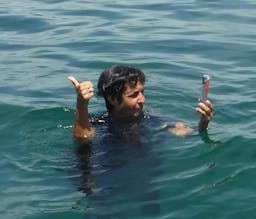Community Cultural Maritime Archaeology in Costa Rica´s Southern Caribbean
Jun 20, 2020
Story

“When communities embrace their own communal maritime archeological culture, archeological work ceases to be only about studying the past; it becomes about re-claiming the historical legacies that are present in our bodies, lives and cultures today; those that have emerged from our interaction with the ocean and waterways. It is about the connections, in order to collectively re-create the present, rooted in its history. When we find material cultural expressions of the past in the oceans of the communities where they ended in the seabed, they immediately interact with the intangible culture wether we like it or not; we might as well accept that they are a critical component of the discoveries because in the intangible is where they recover life again, once found.” (MST, Centro Embajadores del Mar, June, 2019).
Video clip: https://vimeo.com/243230386
“TONA INA IN THE SOUTHERN CARIBBEAN SEA”
The South Caribbean Sea holds historical secrets that have not been enhanced as historical legacies such as the legacy of a community of Afro-Costa Rican origin on the coast of the Cahuita National Park that recalls the tales of the founding myths that the elders did and do today. They spoke of the pirate ships and slave galleons that landed 650 enslaved Africans who were saved from being sold because they reached the coasts of the Southern Caribbean of Costa Rica by mistake of the captains, the sailors rose up and released the Africans who were brought to be enslaved in the Americas.
Of 101 of them, the stories of their re-capture, re-enslaement and even libertarian deeds of slavery are known. The rest remains "disappeared" from the official story, present in the DNA and culture of the people in Alta Talamanca, in the rest of Central America and other latitudes and longitudes at the bottom of the sea and in the territories of the region.
The Community Center of Diving Ambassadors with the communities of the South Caribbean and local authorities of the first Park co-managed by the community and the government, jointly with the University of Costa Rica in the Caribbean wth internationl archaeologists are contributing to expand the history of the Afro-Costa Rican contribution to the South Caribbean culture at different times trying to prove the identity of vessels sunk there. They could be two Danish ships that brought Africans to be slaved from Africa to the Caribbean.
Young people who train in tank diving and who are taking workshops with marine archaeologists at the University of Carolina del Este, are called to clarify the mystery of the place where the Danish ships arrived with the 650 Africans.
They lost their way to Caribbean islands, reaching the coasts of the Costa Rican Caribbean without water, food and without having paid the crew. These rebelled, burning one, sinking the other and carrying the Africans safely to the coasts.
Many disappeared from the official history in the jungles of Alta Talamanca, living with the Bribri and Cabécar. I was the light of their freedom in those mountains of the original people who never let themselves be conquered.
But other Africans from the landing of the ships who walked the beach from south to north until they reached Matina, were captured by settlers in Costa Rica who took them inland and turned them into slaves.
The artifacts of the sunken ships of that event remain at the bottom of the sea without being recognized. There began an important saga, but little known, although it is very well documented in the National Archives.
One of ten TONA INA stories:
A dawn on the coast in 2017, two young people from Cahuita, Dagoberto and Jazmín, are learning to dive with a tank, along with their scuba diving instructors, Frank and Gloria, thanks to the lessons offered by the Community Diving Center.
Gloria, the instructor says: "The sea has no owner or can be parceled, all people are responsible for their care and therefore, the sea you have to feel it, not just observe it."
Frank "the sea's teacher", Gloria, Jasmine and Dagoberto step into the waters little by little, reach an imaginary point, anchor and jump out of the boat in the middle of the bay.
Jasmine fantasizes that maybe, if you look carefully you can see some treasure of pirate ships like the stories that your grandfather Hipolito and his grandmother Terentia have told you.
After being underwater, they suddenly see a strange artifact in a cave, full of conches and corals, with a round mouth and a body lying horizontally, all of the same diameter. When at last they can see well they are shocked by the resemblance they have with a cannon. Everyone looks at each other incredulously and they leave happy because they think they have found the first object of that galleon they were looking for or a cannon from a pirate ship that they had heard so many times.
Frank tells that he has seen a ring, similar to a bracelet that the slaves used and encourages the boys to investigate about those treasures and the ships with slaves that ran aground in that area. He tells them that in addition to diving to see fish, there is also diving to identify sunken ships and artifacts found on the seabed: "the sea is the one that can clarify the enigmas and with divers look for proof of identity and make them part of the legacy of that community. "
Between the Diving School and the community they are sopporting the community co / governance of the Cahuita National Park in order to cintribute to generate income for the new generation: an eco / cultural marine tour, a local museum, a trained and diving-oriented youth team and authorities of the tures, to guide and coordinate the diving of the boats.
https://vimeo.com/243230386




